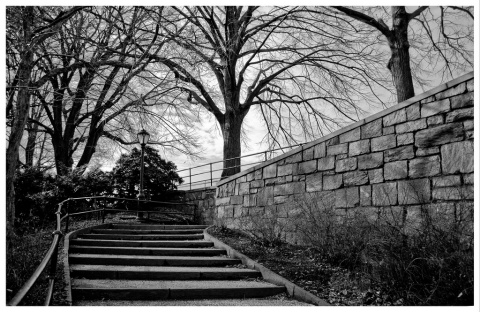Future City Lab: Accessible City IV
Lesson Four: Park Visit
Interdisciplinary

Time Estimate: 120 minutes
Connection to Future City Lab: Living Together: How can we foster a more inclusive city?
Objectives:
Students will:
-
understand Universal Design guidelines and expectations
-
evaluate accessibility in our existing communities
-
recognize the barriers people living with disabilities encounter in their daily lives
-
brainstorm and re-envision built space designs (ie. subway station, park, or school building) with accessibility and universal design
-
construct plans for remediating accessibility issues
Materials:
-
Tape measures
-
Cameras
-
Clipboards
-
Calculators
-
NYC People With Disabilities Statistics (download below)
-
Park accessibility checklist
-
Census data
Standards:
Math
-
8.G.B.7. Apply the Pythagorean Theorem to determine unknown side lengths in right triangles, in real-world and mathematical problems, in two and three dimensions.
-
8.G.B.8. Apply the Pythagorean Theorem to find the distance between two points in a coordinate system.
Social Justice Standards (Social Justice: The Teaching Tolerance Anti-Bias Framework)
-
Justice 12 JU.6-8.12 I can recognize and describe unfairness and injustice in many forms including attitudes, speech, behaviors, practices and laws.
-
Justice 13 JU.6-8.13 I am aware that biased words and behaviors and unjust practices, laws and institutions limit the rights and freedoms of people.
-
Action 20 AC.6-8.20 I will work with friends, family and community members to make our world fairer for everyone, and we will plan and coordinate our actions in order to achieve our goals.
Guiding Question:
-
How do I evaluate accessibility and create accessibility within a space?
- Do Now: Class Review (15 minutes)
- Travel (15-30 minutes, depending on proximity to local park)
- Experiential Activity: At the Park (45-60 minutes)
Procedures
This lesson is designed to give students a real-life application for the Pythagorean Theorem as well as encourage them to think with empathy about the accessibility of space in a hugely diverse city. Previously students worked with a simulation of a real-life scenario, constructing ramps within the classroom and designing ramps to be consistent with ADA regulations. Now they will take the knowledge from that lesson and apply it in a relevant situation of inaccessibility by visiting a New York City park and evaluate its accommodations to persons with ambulatory disability.
Gather inspiration: Take a look at a variety of images that depict universally designed playground space
Class Share: What designs do you find most inspiring? Have you ever been to a park that is Universally Designed?
Check out these directories of Accessible Parks and Playgrounds in NYC: https://www.nycgovparks.org/accessibility; https://www.nycgovparks.org/facilities/playgrounds
Class Review: How many accessible parks are there? Are they near you and your neighborhood? (Note: non-New York City students can plug in the Museum of the City of New York’s address at 1220 Fifth Avenue, New York.) Knowing what we know about MTA accessibility (see Lesson 3 of this series), are they easy for persons with disabilities to reach?
Before you leave, give clear instructions on expectations for conduct on yellow bus, public transportation, or expectations for walking safely. Have students bring pencils, clipboards, accessibility checklists, cameras, and tape measures.
Guidelines:
1.) Students will stay in groups of at least two and no more than four
2.) Students will be given clear parameters and guidelines for expected behavior
3.) Read through the Park Accessibility Checklist. Allow for questions.
4.) Students can then explore the park, searching for spaces of inaccessibility.
5.) Students will work to complete the Park Accessibility Checklist, including taking pictures and measurements once they have identified an inaccessible spot.
6.) Students will come back together for a time of self-assessment and reflection. Have students complete Pythagorean Theorem, sketches, and reflection portions of worksheet at this time so you can be on hand for questions.
Additional Resources
Universal Design Definition and examples of barriers: https://www.cdc.gov/healthyplaces/healthtopics/accessibility.htm
#oneNYC: http://www1.nyc.gov/html/onenyc/about.html
Fieldtrips: This content is inspired by the Future City Lab gallery in the Museum’s flagship exhibition, New York at Its Core. If possible, consider bringing your students on a fieldtrip! Visit http://mcny.org/education/field-trips to find out more.
Acknowledgements
This series of lesson plans for New York at Its Core was developed in conjunction with a focus group of New York City public school teachers: Joy Canning, Max Chomet, Vassili Frantzis, Jessica Lam, Patty Ng, and Patricia Schultz.
This project was made possible in part by the Institute of Museum and Library Services.
The views, findings, conclusions or recommendations expressed in these lessons do not necessarily represent those of the Institute of Museum and Library Services.

